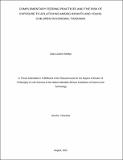Complementary feeding practices and the risk of exposure to aflatoxins among infants and young children in Kongwa, Tanzania
Abstract
Aflatoxins (AFs) are secondary fungal metabolites that commonly contaminate foods like nuts and
cereals and pose major public health concerns like impaired child growth, immune system
suppression, liver cancer and death. In sub-Saharan Africa, infants and young children (IYC) feed
on complementary foods (CFs) containing ingredients susceptible to contamination with AFs.
Although the presence of AFs in foodstuffs has been reported for over 60 years, very few studies
have focused on CFs, yet children are more vulnerable due to relatively small bodyweights and
underdeveloped immune systems. This study was conducted in Kongwa District, Tanzania in 2017
and 2018, to estimate the contribution of the main CF ingredients to aflatoxin exposure among
IYC. The study documented the common ingredients of CFs and the intake of CFs by 35 (6-12-
month-old) IYC using multiple-pass 24-h dietary recalls. The levels of AFs contamination in the
collected samples were determined using High-Performance Liquid Chromatography while the
exposure of IYC to AFs was estimated by a deterministic approach. The study further tested
acceptability of Aflatoxin-safe maize-groundnut pre-blended flour (AFSaBF) and groundnut
powder (AFSaGP). The key ingredients of CFs were milled maize, sorghum, pearl-millet, rice,
and groundnuts (pre- or post-blended with cereals) prepared as thin/stiff porridge. The average
per-capita daily intake of CFs flour was 89.45 g. About 82.14% of the samples had AFB1 levels
ranging from 0.27–317 μg/kg, and the exposure levels ranged from 0.33-1168 ng/kg body weight
(bw)/day. The Margins of Exposure were < 10 000 for all IYC, signifying a public health concern.
The mothers and IYC generally accepted the improved porridge flour and groundnut powder. This
is important information for future studies aiming at reducing exposure to AFs in this community.
Groundnut and maize flours are the main contributors to the exposure of IYC to AFB1 in Kongwa
district. Community education on mycotoxins-mitigation practices like appropriate pre and post harvest handling and complementary feeding practices may minimize aflatoxin exposure among
IYC in Kongwa and other communities with similar settings. Appropriate feeding practices may
entail diet diversification and substitution of groundnut or maize with other food ingredients that
are less-prone to AFs contamination.

